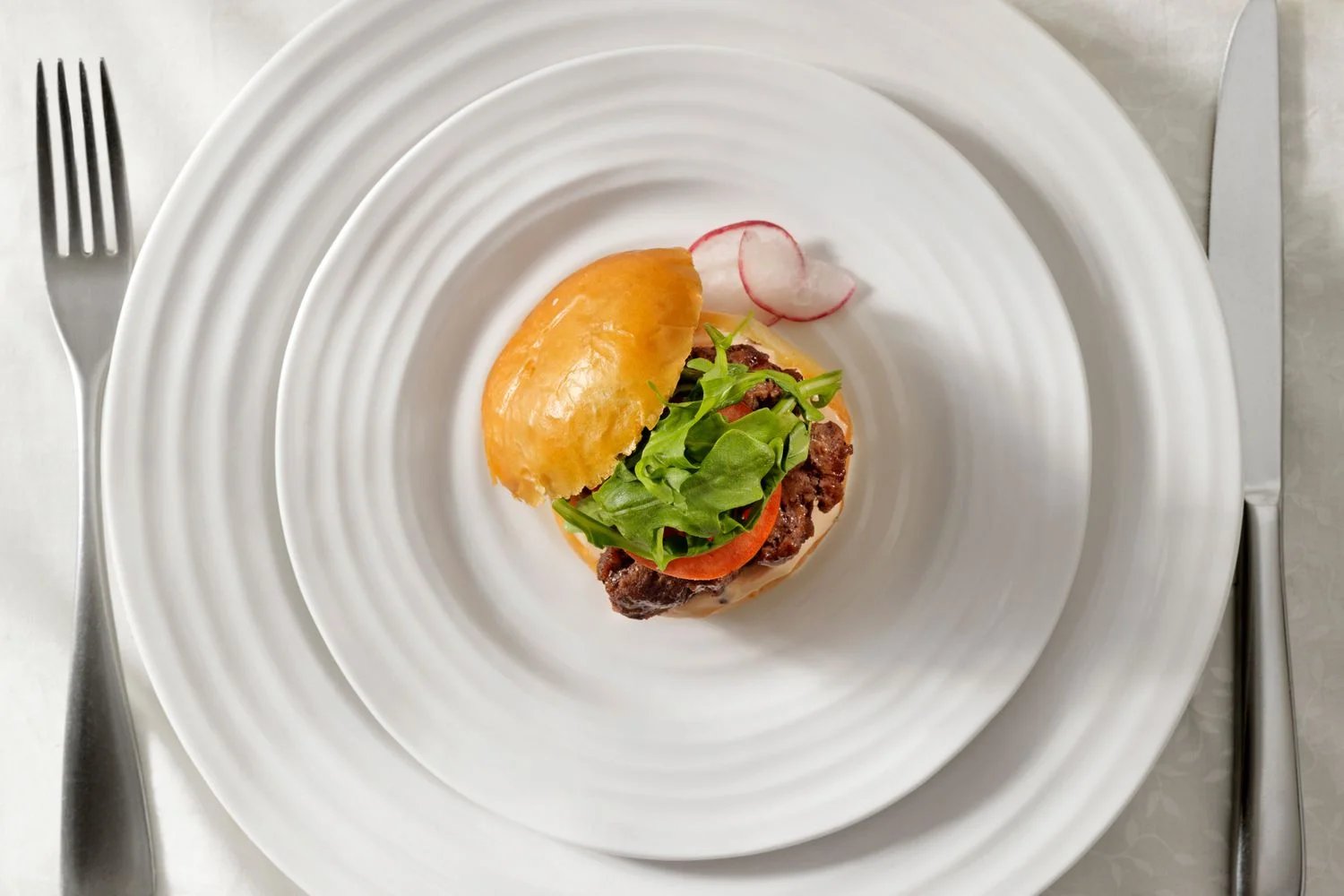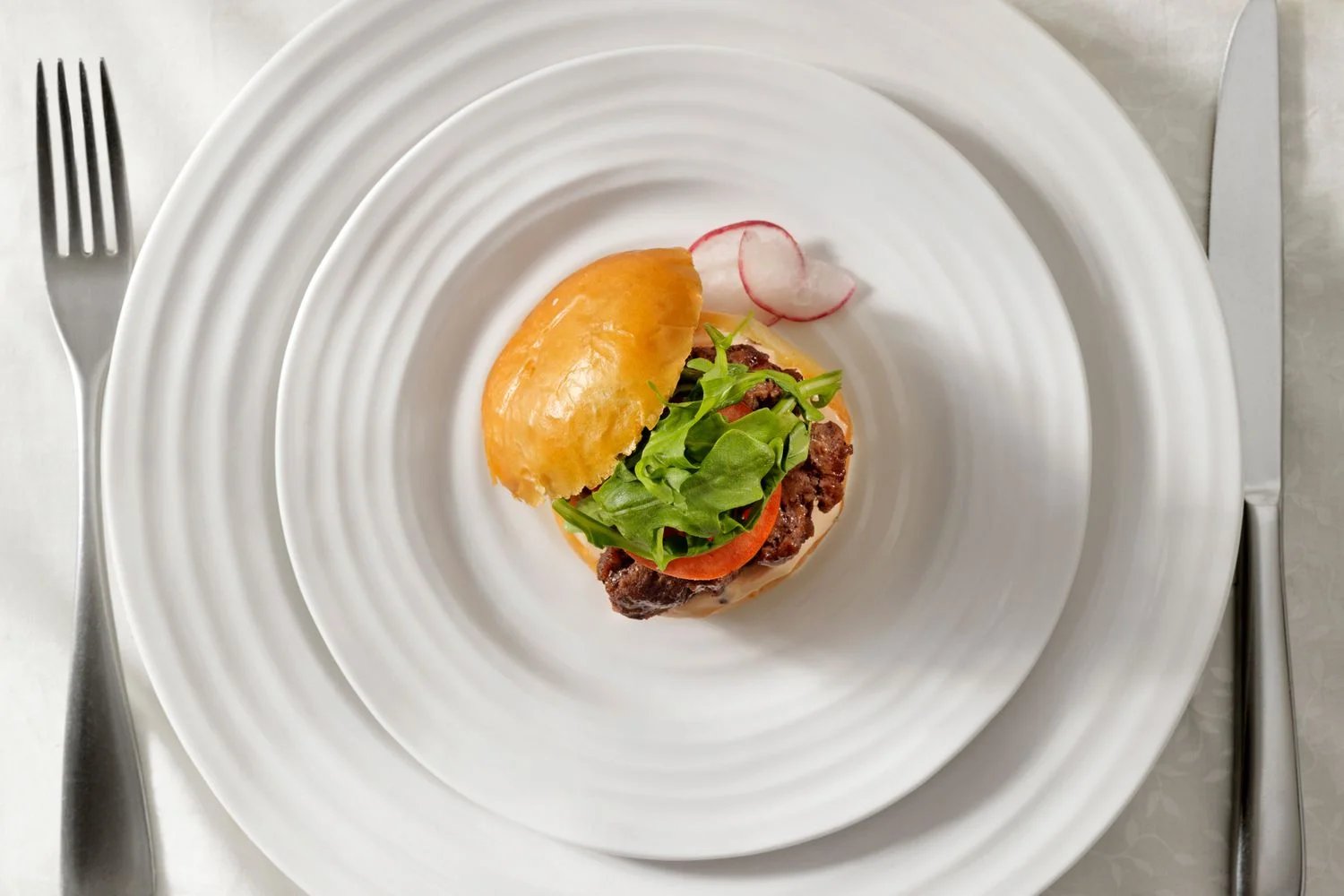
- Restaurants across the U.S. are rethinking portion sizes and menus as the popularity of GLP-1 medications like Ozempic and Wegovy leads diners to eat and drink less.
- Operators such as Clinton Hall and Berg Hospitality Group are introducing smaller dishes or reworking menu staples to emphasize protein and reduce waste.
- As appetite-suppressing drugs reshape dining habits, many restaurateurs are focusing on hospitality, ambiance, and experience to keep guests engaged beyond what’s on the plate.
Walk into any of the four Clinton Hall locations around New York City, and you’ll find a typical beer hall scene. Mozzarella sticks, heaps of nachos, and other bar snacks sit on nearly every table as patrons clink frosty pint glasses. Some may be testing the limits of their stomachs with the CH Challenge, a food feat that requires eating a 20-ounce burger topped with bacon, chicken tenders, and onion rings in less than 25 minutes to get the gargantuan meal for free.
But in striking contrast, one surprising dish may also grace the table: The Teeny-Weeny Mini Meal, which consists of a burger smaller than the size of your fist and five to seven french fries sticking out of a shot glass. The bite-sized dish was added to the menu in response to the rise of GLP-1 medications, a class of drugs that promote weight loss and are typically used to treat diabetes and obesity, but have seen a stunning rise as a weight loss drug.
“I started seeing people taking one or two bites and being done,” says Aristotle Hatzigeorgiou, the owner of Clinton Hall. “It was terrible. Number one, for the waste of food, but also because these restaurants did not have the ability to give that individual something that made more sense. This was our playful alternative to solve that.”
While Clinton Hall’s dedicated menu item addresses some of the challenges restaurateurs face with the rise of GLP-1 medications, widespread usage impacts every aspect of restaurant operations, from the flow of dinner service to financial sustainability, as customers consume and spend less. As appetite-suppressing medications skyrocket in popularity, restaurant operators nationwide are grappling with how to adapt to the changing way people eat, making creative pivots that downsize portions, adjust menu items, and rethink the overall restaurant experience.
Ten to 12% of Americans report using GLP-1 medications like Ozempic and Wegovy, with an additional 14% interested in giving them a try, according to a study released in August by the nonprofit organization RAND. That number is even more prominent among specific demographics, as one in five women ages 50 to 64 say they have taken one of the drugs.
The share of Americans taking GLP-1 medications has risen nearly 600% since 2019, according to a report from nonprofit organization FAIR Health released in May. These numbers are only growing, and various reports expect the industry to clear a valuation of $150 billion by 2023 — easily making it one of the highest-grossing medication categories across the industry.
Since GLP-1 medications work to treat diseases like diabetes and obesity by suppressing a user’s appetite, restaurant professionals report seeing fewer plates covering each table, a decrease in alcohol consumption, and other changes that squeeze this challenging industry even tighter.
Benjamin Berg, the founder and CEO of Berg Hospitality Groupcrunched the numbers to back up the changes he has seen at his 14 restaurants across Texas. He estimates that side dish orders are down about 30% and large groups are also scaling back the number of appetizers they order for the table.
Berg’s portfolio of restaurants includes a few high-end steakhouses like Turner’s and Prime 131 in Houston. These restaurants rely on guests ordering appetizers like beef tartare and raw bar towers to boost check averages and maintain profitability. But Berg says ordering a few dishes to share at the table is “down dramatically.”
He also notes that hearty side dishes you’d expect to find at a steakhouse, like creamed spinach and decadent mac and cheese, aren’t as popular as they once were. Rather than developing brand-new, medication-specific menu items to address the changing way diners are eating, Berg says his team is rethinking menu staples. For example, lobster mac and cheese has been replaced with protein-forward side dishes like lobster basted in white wine and butter.
“We’re in the business of taking you away from your life for a couple of hours. We want to create a great experience,” Berg says. “We still want you to have that decadent experience. But we’re also listening to the guests and watching how the guests are ordering.”
Medical professionals advise GLP-1 users to increase their intake of protein and fiber to make every bite count, as they eat less overall, which is what prompted Berg to make that particular change. He says he has noticed more people swapping carbs for protein even if they’re not taking a weight-loss drug.
These changes are also showing up on grocery store shelves. Congara Brands, the company behind Healthy Choice frozen meals, added labels to select items that are high in protein, low-calorie, and a good source of fiber to denote that they are “GLP-1 friendly.” Daily Harvest rolled out a special GLP-1 Support package of smoothies and other freezer meals, while Nestle launched an entirely new brand called Vital Pursuit, catering to GLP-1 users.
The 411 on GLP-1
What are GLP-1 medications? GLP-1, which stands for glucagon-like peptide 1, is a naturally occurring hormone in your body that regulates blood sugar, controls appetite, slows digestion, and signals to the brain that you feel full. These medications are colloquially called GLP-1 medications because they contain drugs like semaglutide, tirzepatide, and liraglutide, which mimic the GLP-1 hormone in your body.
How do they work? GLP-1 medications promote weight loss, so they are often used to treat conditions like diabetes, obesity, and more. Many users describe feeling “quieted food noise” or eliminated cravings, so people who use the medications consume less and therefore lose weight. Most GLP-1 medications are taken as a weekly injectable, but some brands offer daily pill forms as well.
Neal Bodenheimer, a partner at New Orleans cocktail bars like Cure and Cane & Table and Dauphine’s restaurant in Washington, D.C., says that while his venues haven’t made any changes with medications like Wegovy and Munjaro in mind, he’s thinking more about hospitality than ever before.
“It used to be that our secret weapon was hospitality, but people came for the food and drink,” says Bodenheimer. Now the emphasis has shifted from what’s on your plate and in your glass to the overall experience, he says.
Bodenheimer notes that, whether it’s due to the rise of GLP-1 medications or other factors, guests in recent years have paid more attention to the design of a space and their overall experience. That means he expects music, interior design, and other elements that make up a restaurant’s ambience to become more critical in the coming years.
For the most part, restaurateurs say it’s hard to pin down precisely what is causing changes in consumption behavior, so they’re waiting to see how the GLP-1 craze will play out. Abraham Merchant, president and CEO at Merchants Hospitalityis paying attention as many companies work on getting FDA approval for pill versions of GLP-1 medications, a change he anticipates will lead to “even greater adoption and more noticeable changes in dining patterns.”
“Over time, we expect the industry will recalibrate menus and portion sizes to align with evolving appetites and lifestyles,” Merchant says. “For now, we’re simply observing the shift.”
In convivial spaces like cocktail bars and buzzy restaurant dining rooms, it’s tough to square cutting back with providing a memorable time. Like many restaurateurs, Bodenheimer worries about his industry’s position if guests lose their “zest for eating and drinking” due to GLP-1 medication use.
“You’re in business to make money, but I don’t just do this to make money. I do this because I want to make people happy,” he says. “I want to serve people things that delight them and that they enjoy. So if I turned around one day and no one was enjoying the work that we were doing, I don’t know if I would want to do it.
Disclaimer: This news article has been republished exactly as it appeared on its original source, without any modification.
We do not take any responsibility for its content, which remains solely the responsibility of the original publisher.
Author: Liz Provencher
Published on: 2025-10-19 17:03:00
Source: www.foodandwine.com
Disclaimer: This news article has been republished exactly as it appeared on its original source, without any modification.
We do not take any responsibility for its content, which remains solely the responsibility of the original publisher.
Author: uaetodaynews
Published on: 2025-10-19 17:10:00
Source: uaetodaynews.com
